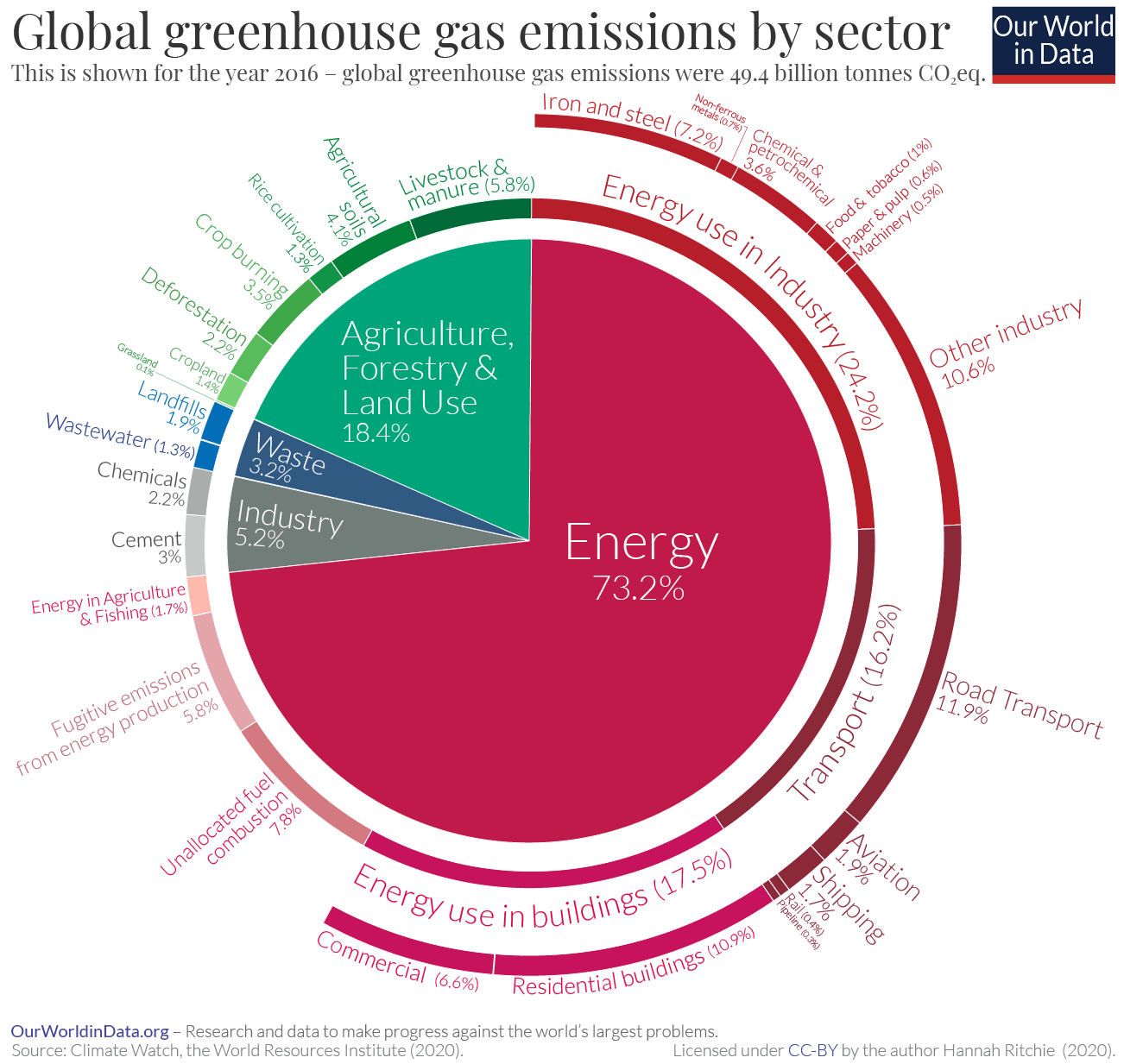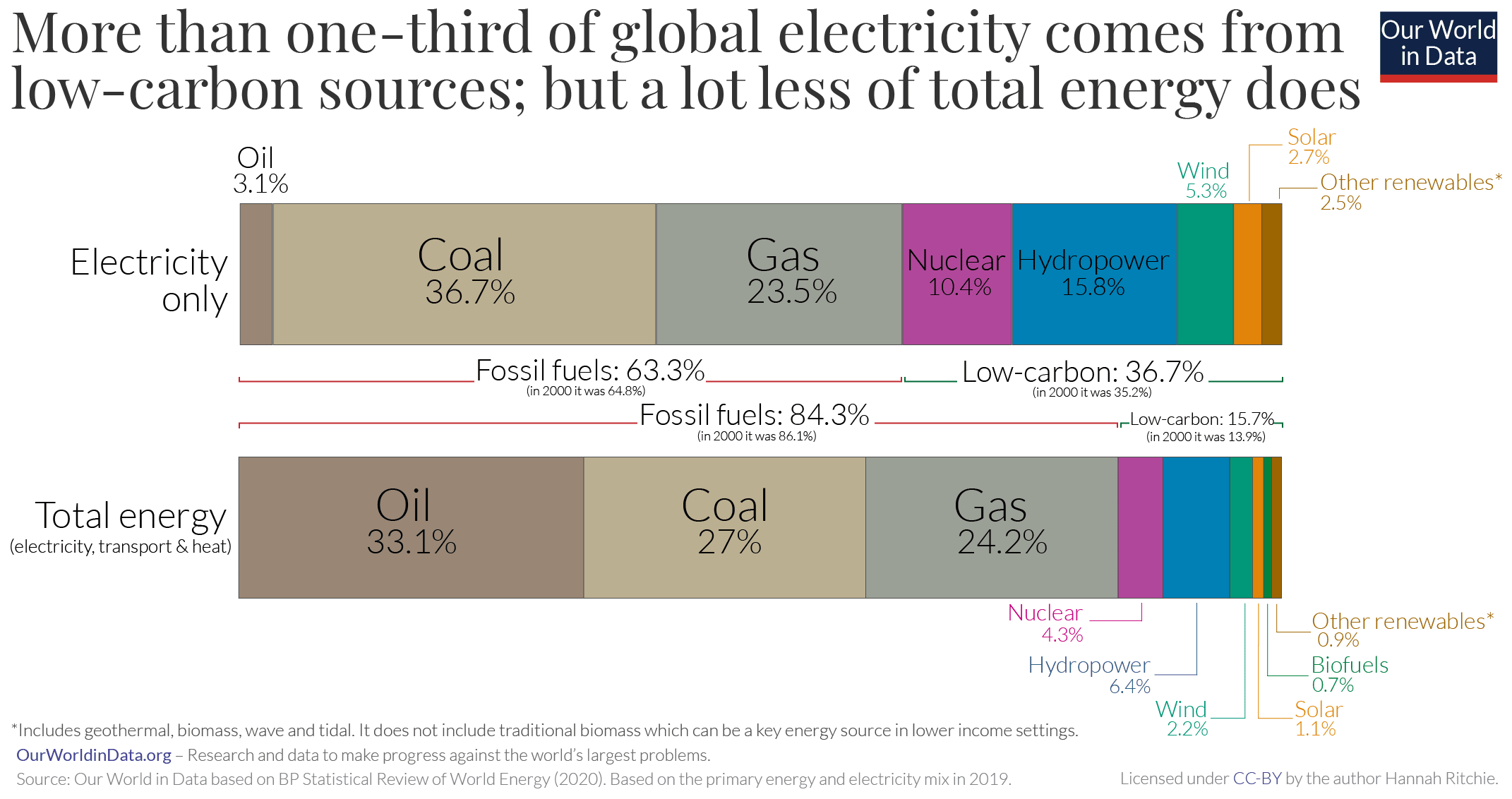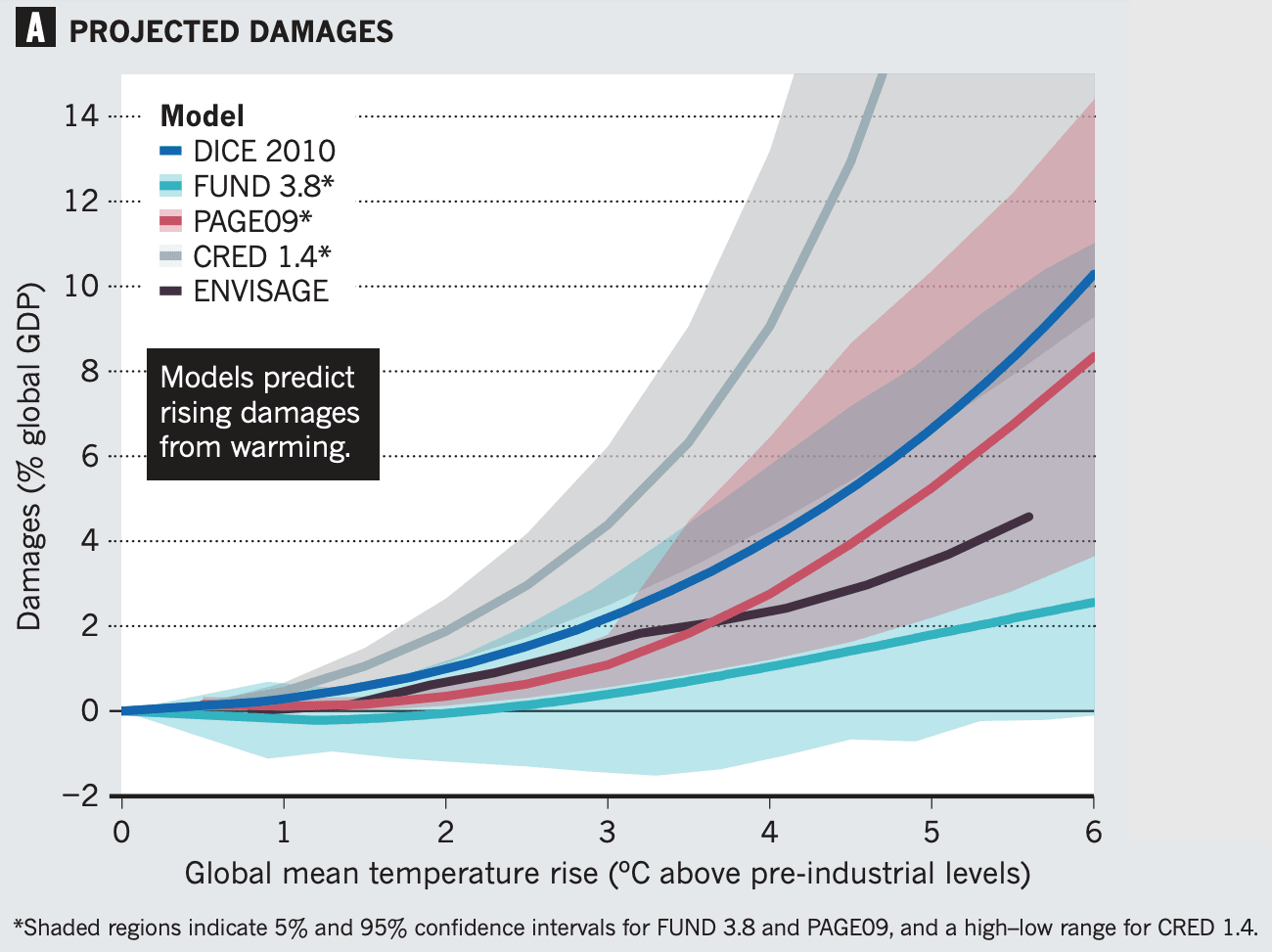Cross-posted from the High Impact Engineers Resource Portal. You can view the most up-to-date version on the Portal.
Edited 11th October 2023 to update links.
Summary
Climate change is a cause area that needs no introduction - you’re probably already very aware of human-caused climate change and its myriad socioeconomic consequences.
However, our take on climate change is a little different than the typical perspective. Assessing climate change with the ITN framework, climate change is (of course) important and has many tractable interventions; but with annual international investment over 630 billion USD and extensive academic and political discourse, it isn’t as neglected as other cause areas we have explored.
Given this, we recommend that engineers who are interested in working on climate change pursue interventions that are potentially very effective but aren’t widely discussed. This could look like improving nuclear energy, decarbonising building materials, or maturing a technology that could be highly impactful if commercialised, such as direct carbon capture or super hot rock geothermal energy. Other neglected areas of interest could include technologies that mitigate the worst tail-end effects of catastrophic runaway climate change.
Uncertainty
The content of this article is largely based on research by 80,000 Hours, the Clean Air Task Force, Founders Pledge, and the UN in their Climate Action reports. We feel substantially confident in the information and recommendations in this article.
- There have been arguments that ITN is a framework that doesn’t always apply, or that the Significance, Persistence, Contingency framework should be used instead - your evaluation approach may significantly affect how you rank working on climate change against other cause areas.
- Despite the amount of research into climate change, there are still some key questions that remain unanswered. Robust conclusions about climate change are hard to find, especially when trying to understand what might be the worst possible outcomes.
Cause area overview
Is climate change the most pressing problem?
Climate change is often the first area that altruistically-minded engineers gravitate to working on. Extreme weather phenomena are becoming much more frequent, economic costs of warming this century could potentially be up to 51% of global GDP, extinction rates are increasing to 10-100x pre-human rates and potentially threatening a million species, and an estimated 3.3 to 3.6 billion people live in contexts that are highly vulnerable to climate change. It is clear that climate change has already been, and will increasingly be, extremely destructive as global surface temperatures rapidly approach the watershed 1.5°C rise.
A global survey found that over half of young people worry that humanity is doomed due to climate change. Although it is completely justified to feel angry and afraid for the future, it seems that, in comparison to other cause areas (like Biorisk and Biosecurity and Civilisation Resilience), climate change is much less likely to cause doom to humanity or be an existential threat to civilisation.
Climate change also receives significantly more resources (e.g. private and public investment, technical talent) and international attention (e.g. academic and political discourse, activism) than other cause areas, meaning that you are more likely to have more impact elsewhere. We think these arguments are worth some serious consideration before you decide to continue pursuing work to mitigate climate change.
In short, research on the extreme effects of climate change is somewhat lacking and remains fairly speculative, but climate change is unlikely to directly cause human extinction or civilisation collapse. That being said, climate change would cause huge stress on the systems that make up civilisation, such as reducing international peace and cooperation, and could exacerbate the effects of other global catastrophes.
However, if you aren’t particularly concerned about existential risks you may place less weight on the above arguments. There are other reasons why one would be deeply concerned about climate change: current projections predict 2.8°C of warming (which would definitely be devastating), and there's a larger than 1% chance that the Earth will experience 6°C of warming, which would create an almost unimaginably different world from the one that we’re living in now. More extreme weather events would cause severe destruction to homes, communities, economies, ecosystems, and agriculture. Many species on land and in the ocean would become endangered or extinct as temperatures rise, the oceans become more acidic, and invasive pests, diseases, wildfires and extreme weather threaten the delicate balance of the ecosystem.
Figure 1: Rising sea levels could displace hundreds of millions of people within this century (Photo by Robert De Bock on StockSnap)
Further to the destruction of the environment, climate change is a huge threat to human health: “through air pollution, disease, extreme weather events, forced displacement, pressures on mental health, and increased hunger and poor nutrition in places where people cannot grow or find sufficient food. Every year, environmental factors take the lives of around 13 million people” (UN).
Climate change could increase global instability, as weather-related events displaced an estimated 21.5 million people on average each year over the past decade. This is more than twice the number of people displaced due to conflict and violence. Most refugees come from countries that are most vulnerable, contribute least to greenhouse gas emissions, and least ready to adapt to the impacts of climate change. These are all compelling reasons to care about climate change. Reactions to relatively small disturbances can be amplified in societal processes, according to Johannes Ackva, a researcher at Founders Pledge. It’s unclear whether society will be able to mitigate the different effects of climate change, or make them worse.
Heuristics for deciding which interventions to work on
If you’ve engaged with these arguments and you are still sure that climate change is the problem in which you can have the most impact, it’s important to find the most effective intervention for you to work on. Engineers have many opportunities to work on interventions that tackle climate change, from electric vehicles to carbon capture, but some interventions are much more impactful than others.
For instance, car emissions are only ~2x higher than emissions from cement (Our World in Data), but there’s almost 10x the investment on electric cars ($225bn global investment in EVs and batteries by car makers (excluding battery manufacturers and researchers) in 2020 vs $25bn into green cement in 2021). This suggests that there are better opportunities — “low-hanging fruit” — for your efforts to reduce emissions by greening cement production. In our view, this kind of “on the margin” thinking is particularly important when there is so much attention and interest in working on climate, to think outside the issues with the most attention and understand where your efforts could go further and have more counterfactual impact. You can find out more about this kind of strategic thinking in Johannes Ackva’s recent episode on climate interventions on the 80,000 Hours podcast.
Resource suggestion: Johannes Ackva on unfashionable climate interventions that work, and fashionable ones that don’t
As Martin Hare Robertson writes in his advice for technologists who want to work in climate change, it is impossible to know the ‘best’ choice for what to work on and where. His suggestion is to find something that has a clear link with driving down emissions, and do that. If you have multiple options, pick the one with the highest plausible impact. There are no easy answers, but having high uncertainty does not imply ignorance — you can still make decisions based on the information you have.
Below, we’ve attempted to find the industries that are plausibly the most impactful for tackling climate change.
How can engineers do impactful work in climate change?
Causes of human-caused climate change
The burning of fossil fuels (oil, coal, and gas) account for over 75% of global greenhouse gas (GHG) emissions and ~90% of all carbon dioxide emissions (UN), which trap the sun’s heat and raise the surface temperature of the Earth, causing long-term shifts in weather patterns and other devastating effects on our environment. Figure 2 shows the main sectors that contribute to GHG emissions:
Figure 2: Infographic of global greenhouse gas emissions by sector (Our World in Data)
Generating energy/power
Although the generation of electricity is shifting away from fossil fuels, this is only one component of total energy consumption. Total energy consumption is the sum of electricity generated, demand for energy from transport, and from heating.
Transport and heating rely much more heavily on fossil fuels than electricity, which is why fossil fuels account for more than 80% of the global energy consumption. Decarbonising electricity is only one step towards a low-carbon energy system. Climate philanthropists skew their funding heavily towards clean electricity, while continuing to overlook other sectors that are harder to decarbonise – these are the sectors that desperately need more attention (Founders Pledge).
Figure 3: Infographic comparing the sources of electricity and energy (Our World in Data)
Global energy consumption is growing year on year, outstripping the pace of decarbonisation. It is the absolute amount of carbon dioxide that has an impact on global warming. Decarbonisation needs to grow quickly enough to meet our new energy demands each year, but also start displacing fossil fuels in the energy mix at a much faster rate. Clean energy needs to expand to emerging economies with high future emissions such as India, Southeast Asia, and Sub-Saharan Africa, without restricting energy access and the resulting perpetuation of poverty (Founders Pledge).
Project Drawdown predicts that onshore wind turbines could reduce emissions between 2020 – 2050 by 47 – 144 gigatons CO2 equivalent. Utility-scale photovoltaics could cut emissions between 2020 – 2050 by 41 to 112 gigatons CO2 equivalent. It’s worth noting that Project Drawdown is heavily focused on implementing existing solutions, rather than engineering new solutions. As a result, the main bottlenecks they focus on are in policy rather than technical innovation.
Manufacturing goods
The manufacturing process, from mining raw materials to the production of things like cement, aluminium, steel, electronics, plastics, clothes, etc. is one the largest contributors to greenhouse gas emissions worldwide.
Figure 4: Cement accounts for 3% of the world’s carbon dioxide emissions (Photo by Operation Camp on StockSnap)
Mining and other industrial processes release gases, as does the construction industry (cement contributes ~8% of global carbon dioxide emissions). Manufacturing machines often run on fossil fuels. Furthermore, some materials like plastics are made from chemicals sourced from fossil fuels.
Industry accounts for 24% of the GHG emissions in the US (inclusive of GHG emissions from energy generated for industry - i.e. indirect GHG emissions). Industry accounts for 24.2% of global energy use, and produces a further 5.2% of global GHG emissions.
Industrious Labs is an environmental campaign organisation that strategically coordinates other organisations to decarbonise heavy industry.
Transportation
Transport accounts for 16.2% of global GHG emissions (not including emissions from the manufacturing motor vehicles or other transport equipment - that is included in the previous point “Manufacturing goods”).
Figure 5: Transport accounts for 16.2% of global GHG emissions (Photo by Kiki Zhang on StockSnap)
Road transport is the largest contributor to GHGs for transport. Passenger travel (cars, motorcycles, buses) causes 60% of road transport emissions. Road freight (lorries and trucks) account for the rest.
81% of aviation emissions (1.9% of global GHGs) come from passenger travel (of which 60% is attributed to international travel and 40% to domestic). 19% of aviation emissions come from freight.
Project Drawdown has a list of other solutions to decarbonising the transportation sector. It’s worth noting that Project Drawdown is heavily focused on implementing existing solutions, rather than engineering new solutions. As a result, the main bottlenecks they focus on are in policy rather than technical innovation.
Agriculture
Agriculture, forestry and land use directly produce 18.4% of global GHG emissions. If GHG emissions are calculated for the food system as a whole (including refrigeration, food processing, packaging, and transport), this number goes up to about 25% of global GHG emissions.
Figure 6: Agriculture, forestry and land use directly produce 18.4% of global GHG emissions (Photo by Ian Livesey on StockSnap)
Livestock and manure are the largest direct contributors to agricultural GHGs. Cows and sheep in particular tend to have a high carbon footprint due to their digestive process that produces methane as a by-product. This means that reducing your consumption of beef and lamb is an effective individual intervention to reduce the environmental impact of your diet.
Project Drawdown calculates that plant-rich diets could cut 78 – 103 gigatons CO2 equivalent between 2020 – 2050. Developing and commercialising Alternative Protein could catalyse a societal shift to plant-rich diets through bringing price-competitive meat alternatives to market.
See our page on Alternative Protein
Powering buildings
Energy for residential buildings produce 10.9% of the world’s GHGs, while commercial buildings generate 6.6%. These GHG emissions can be produced by the generation of electricity for lighting, appliances, cooking, and heating. Technologies to decarbonise electricity already exist; the main bottlenecks are in policy rather than in technical development.
Overconsumption
Our lifestyles have a profound impact on our planet. Although companies and governments have the most responsibility to bear when it comes to GHGs, our individual consumption choices also collectively contribute to GHG emissions. Find out how many Earths it takes to support your lifestyle — you might notice that even if you picked the most eco-friendly options, if you’re from developed countries you’ll still require more than 2 Earths. This is because a country’s climate policy dramatically changes the impact of people’s lifestyle choices (Founders Pledge). However, one significant large-scale study outlined that eating a vegan diet could be the “single biggest way” for individuals to reduce their personal negative impact on the environment.
Project Drawdown estimates that reducing food waste could cut 88 – 102 gigatons CO2 equivalent between 2020 – 2050. Advocating for policy change is likely to be the most effective way for an individual to change our collective behaviour.
Tackling climate change as an engineer
Figure 7: Photo by ThisisEngineering RAEng on Unsplash
It seems particularly tractable for engineers to tackle climate change, as many of the solutions involve developing and implementing technologies that are less reliant on burning fossil fuels, or making them more economically viable. Here we explore few technologies that we think are particularly neglected by engineers working on climate.
Superhot rock geothermal energy
A visionary technology that has the potential to meet long-term demands for zero-carbon, always-on power is superhot rock geothermal energy.
Superhot rock geothermal energy can be generated from dry rock that’s 400C or higher. It exists all over the earth at depths between 2 - 12 miles (3 - 20 km). However, it’s almost entirely unrecognised in the decarbonisation landscape.
The Clean Air Task Force, a climate non-profit, finds that with investment in innovation, superhot rock geothermal energy can be commercialised and deployed rapidly in the 2030s. It could be cost-competitive with other zero-carbon technologies while also, importantly, having a small land footprint.
There are many opportunities for all kinds of engineers in this area. We think that Reservoir Engineers and other Petroleum Engineers are likely to have transferable skills (e.g. experience in deep drilling) that could be applicable to this industry.
Nuclear energy
Nuclear energy has been around for more than half a century and is one of the safest, cleanest, and most reliable sources of energy. The biggest hurdles to nuclear fission are mostly in regulation and a negative public perception, so a career in policy or advocacy is likely to be the most impactful in this area. However, there are some technical bottlenecks that require engineering expertise to solve, such as in Advanced Modular Reactors. Read more in the Nuclear Energy sub-page.
Energy efficiency
Increasing energy efficiency (e.g. reducing the cost of insulated buildings) would reduce total energy consumption. Project Drawdown expects retrofitting buildings with insulation to cost-effectively cut emissions by 15.4 – 18.5 gigatons CO2 equivalent by 2050. However, it is incentivised by the market, and it is not very neglected according to this Founders Pledge report.
Managing methane leaks in oil and gas supply chains could reduce GHG emissions by 25.8 to 31.3 gigatons of CO2 equivalent by 2050.
As of 2020, the proportion of households without access to clean cooking was ~36%. Traditional biomass-based cooking produces black carbon, the second-most impactful climate pollutant, along with plumes of smoke and soot that pose significant health hazards and contribute to millions of premature deaths each year. Project Drawdown estimates that switching to clean cookstoves could reduce emissions by 31.4 to 76.3 gigatons of CO2 equivalent by 2050, as well as deliver concomitant health and social benefits.
It could be impactful to identify and reduce the barriers to deploying and scaling technology that’s already been developed to find potentially neglected ways to lower cost. Low-carbon and energy-efficient technology could help to tackle emissions from industry.
Decarbonising heavy industry
Since heavy industry accounts for around 1/3 of global GHG emissions, decarbonising these complex production processes could be highly impactful. Heavy industry is usually relatively difficult to decarbonise compared to other emissions sources, and requires specific solutions.
High-leverage opportunities are mostly in corporate and government spending and decision-making (where Industrious Labs, a Giving Green-recommended non-profit, operates), but there are significant engineering bottlenecks in this area. Decarbonisation is likely to have positive externalities, such as reduced pollution of the local environment.
Carbon capture, removal and storage technologies
Carbon capture, removal and storage technologies are essential to most net-zero scenarios. The most promising technologies are the carbon dioxide removal (CDR) technologies that take carbon dioxide straight out of the air. These are the most likely to become the negative emissions technologies that are necessary to tackle climate change. With low confidence, we believe that CDR is most important and neglected of these carbon capture, removal and storage technologies, and the current bottlenecks in development and deployment are very technical.
However, there is a risk of carbon capture being used for enhanced oil recovery (EOR) and other fossil fuel interests, which is probably net harmful. Read more about carbon capture technologies and their risks on the Carbon Capture, Removal and Storage sub-page.
Research into the most extreme risks of climate change
Although there is much research on the likely outcomes from climate change, more work needs to be done to understand the most extreme risks of climate change, and how to reduce these risks.
What are the different extreme risks?
- Three of the most common ways people say climate change might directly cause human extinction include high temperatures, rising water, and disruption to agriculture. Climate damage is expected to be non-linear with increasing temperature, with risks being much higher at higher temperatures. Figure 9 shows projected damages from warming temperatures (these models have been criticised for likely underestimating climate damage, but the important takeaway is not the absolute level of climate damage, but the shape).
Figure 9: Expected climate damage with rising temperatures (Revesz et al. 2014)
- This non-linearity means that it is more important to shift from 5 to 4.5 degrees warming in a 5-degree scenario than it is to shift from 3 to 2.5 degrees in a 3-degree world. Even if a 5-degree world is less likely than the 3-degree one (e.g. because it is likely that all mainstream solutions succeed to land us in the 3-degree world, rather than the 5-degree world), working on solutions to prevent the worst from happening in a 5-degree world could be vital if current mainstream solutions fail (see Founders Pledge).
- The worst-case climate scenarios would be devastating to human lives and the planet. However, 80,000 Hours predicts that this destruction, even at 13°C of warming, is unlikely to cause humanity to go extinct.
- Even in the IPCC’s Sixth Assessment Report, which accounts for unknown unknowns and structural uncertainty (uncertainty in predictions because we don’t know entirely how systems work), they find it unlikely that the sum of these uncertainties would be biased towards one direction (i.e. for every consideration that could increase warming, there are considerations that would decrease it, so they mostly cancel out).
- However, 80,000 Hours have highlighted a few caveats:
- “The higher our emissions are, the further they get from the sorts of baseline assumptions the IPCC used to come to this conclusion. So if we’re really very wrong about the amount of carbon emissions we’re likely to emit, things could still get very bad (but it seems unlikely we’re very wrong about that).”
- “There is much more uncertainty about how other things will change. For example, it’s hard to predict how high sea levels will rise or how precipitation patterns will change (although even then we don’t think these things will change in ways that increase the direct risk of extinction).”
- If you think 80,000 Hours are missing key elements in their evaluation, it could be impactful to look into these uncertainties.
What can we do to mitigate these risks?
- More research in the effects of climate change, specifically the effects of feedback loops, would allow a more thorough understanding of the risks.
- Climate change is also likely to make other catastrophic risks worse, e.g. by increasing migration, which could lead to instability. More research is needed to understand how climate change interacts with other potential catastrophic risks.
‘Greening’ agriculture
As discussed in the ‘Agriculture’ subsection within ‘Causes of Climate Change’, livestock and manure are the largest direct contributor to agricultural GHGs.
We believe that developing Alternative Protein options is the most promising technical route to reducing agricultural emissions. Making alternative proteins more delicious, cheaper, and accepted could bring other benefits such as reducing farmed animal suffering, antibiotic resistance, soil erosion, agricultural water use, and potentially freeing up to 3 billion hectares of land.
Figure 9: Ivy Farm is a cultivated meat focused on tackling the challenges of sustainable meat production. Photo by Ivy Farm on Unsplash
Future animal consumption and production is likely to be in low- and middle-income countries (LMICs), where alternative proteins are less ubiquitous and underdeveloped. This could provide a unique opportunity for engineers situated in LMICs to contribute.
See our page on Alternative Protein
There may be other ways to engineer agriculture to be greener, such as in this article, but more research is needed to clarify how effective these would be.
Ways you can contribute (your engineering skills) to climate without being an engineer
As an engineer, your numerical skills and technical knowledge can be very valuable in other types of roles. These roles could include:
- Policy, advocacy and leadership
- Climate finance/venture capital
- Grantmaking
- Donating to effective climate charities
Read more about these in the subpage:
Other ways to contribute to climate change without being an engineer
Risks, pitfalls, and things to keep in mind
Carbon capture for enhanced oil recovery
As outlined in Carbon Capture, Removal and Storage, we do not recommend working in carbon capture for enhanced oil recovery (EOR). Unfortunately, EOR is the most economically valuable (and potentially most common) use for captured CO2, so this could be difficult to select for when finding a job in this area.
Greenwashing
Most large engineering companies have at least one team working on sustainability. However, it’s not always clear how much influence or impact you might have working in that particular role. Arguably most jobs in climate aren’t all that effective, with many companies routinely exaggerating or misreporting their progress. To maximise your likelihood of having an impact, it may be a good idea to do your research into the company to understand the true impact of a particular role there.
Replaceability and counterfactual impact
70% of 1000 employees at large US companies are more likely to work for a company with a strong environmental policy (similar to the 65% of 2000 respondents to Unily’s 2020 report on UK-based office workers) and nearly half of all respondents and three-quarters of millennial workers would be willing to accept a smaller salary to work for a company that’s environmentally responsible. In our experience, most engineers keen to make a social impact first land on climate change as an area in which to do good. This means that it is likely that ‘green jobs’ are in higher demand, so the next best engineer for the job is likely to do just as good a job as you would have done. As a result, your counterfactual impact in climate change is unlikely to be very high, and you’re likely to be relatively replaceable in climate change work relative to other cause areas. However, if you have an especially good personal fit for the position, then you’re probably not as replaceable.
We are grateful to ET for their input and feedback. All remaining mistakes are my own.










As someone who has worked in sustainable energy technology for ten years (wind energy, modeling, smart charging, activism) before moving into AI xrisk, my favorite neglected topic is carbon emission trading schemes (ETS).
ETSs such as implemented by the EU, China, and others, have a waterbed effect. The total amount of emissions is capped, and trading sets the price of those emissions for all sectors under the scheme (in the EU electricity, heavy industry, expanding to other sectors). That means that:
It's just crazy to think about all the good-hearted campaigning, awareness creation, hard engineering work, money, etc that is being directed to decreasing emissions for a sector that's covered by an ETS. To my best understanding, as long as ETS is working correctly, this effort is completely meaningless. At the same time, I knew of exactly one person trying to reduce ETS emission rights based in my country, the Netherlands. This was the only person potentially actually achieving something useful for the climate.
If I would want to do something neglected in the climate space, I would try to inform all those people currently wasting their energy that what they should really do is trying to reduce the amount of ETS emission rights and let the market figure out the rest. (Note that several of the trajectories recommended above, such as working on nuclear power, reducing industry emissions, and deep geothermal energy (depending on use case) are all contained in ETS (at least in the EU) and improvements would therefore not benefit the climate).
If countries or regions have an ETS system, successful emission reduction should really start (and basically stop) there. It's also quite a neglected area so plenty of low hanging fruit!
Context: I've worked in carbon pricing / emissions trading systems for several years before joining FP and I am generally not shy to criticize efforts that have low additionality (indeed, I partially left that role because of impact concerns).
1. It is true that it *used to be true* that reducing emissions in EU ETS sectors had zero impact on European emissions because of the dynamics you outline (the so-called "waterbed effect").
However, this has not been true for several years now with the introduction of the Market Stability Reserve (MSR). Now everything is a lot more complicated, but at least the effect of "no effect" is somewhat mediated.
2. Maybe not from the activist community, but from economists and other policy wonks, there is a lot of attention to the EU ETS and there has just been a recent strengthening of the EU ETS. It is the one thing every economist agrees on.
3. Given Europe's low share of future emissions and high share of innovation capacity, the fact that actions do not matter much more for Europe (because of the partially existing waterbed effect) is not as damning as it sounds. A lot of actions can still be very important. For example. Germany's massive support for renewables is sometimes criticized to not have reduced emissions because it was in an EU ETS sector (electricity) at a time when the waterbed effect was still fully in place. While this is true, it kind of barely matters because by far the largest effects of these policies were indirect anyway, changing the global trajectory of solar and driving emissions reductions in sunnier countries unwilling or unable to make the initial investment that Germany and some other made to drive down the cost.
Crucially, though, this waterbed effect does somewhat affect "local" prioritization, e.g. it is an additional reason to prioritize action based on global consequences (e.g. changing trajectory of early-stage technologies) because local emissions reductions matter even less than on emissions ground alone. E.g. one should be even more excited for changing the trajectory on cement vs adding a bit more solar than one should already be.
(No sources here, but I discuss this is more on the recent 80K Podcast)
Thanks for your reply. I mostly agree with many of the things you say, but I still think work to reduce the amount of emission rights should at least be on the list of high-impact things to do, and as far as I'm concerned, significantly higher than a few other paths mentioned here.
If you'd still want to do technology-specific work, I think offshore solar might also be impactful and neglected.
I think the list here is optimized for engineers, i.e. people with backgrounds that are better at working on technology than lobbying, so this is likely the proximate reason it is not on the list (I had no input on the list).
That said, whether working on emissions rights is a top priority after the recent reforms is a question that would require more work (I think it is plausible to say we are close to having maxed out on ambition, and also changes in emissions rights are primarily driven by changes in general climate policy support, it seems).